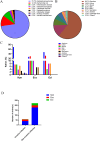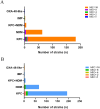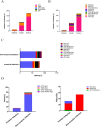Epidemiological Characteristics and Carbapenemase Analysis of Carbapenem-Resistant Enterobacterales Isolates in a Teaching Hospital in Guangzhou, China
- PMID: 40303604
- PMCID: PMC12039840
- DOI: 10.2147/IDR.S507692
Epidemiological Characteristics and Carbapenemase Analysis of Carbapenem-Resistant Enterobacterales Isolates in a Teaching Hospital in Guangzhou, China
Abstract
Background: In this study, carbapenem-resistant Enterobacterales (CRE) were isolated from a teaching hospital in Guangzhou between January 2020 and March 2023, meticulously examining the antimicrobial resistance patterns, carbapenemase types, and epidemiological characteristics of these isolated strains. This comprehensive analysis serves as an invaluable insight for optimizing CRE treatment strategies for clinical practitioners and implementing robust measures to prevent and control nosocomial infections within healthcare settings.
Methods: The antimicrobial susceptibility testing aimed to ascertain carbapenem resistance in Enterobacterales, while the production of carbapenemase was assessed through rapid phenotypic identification by immunochromatographic assay (KPC, NDM, VIM, IMP, and OXA-48-like) and confirmed by PCR.
Results: Among the 300 CRE strains collected from January 2020 to March 2023, Klebsiella pneumoniae (CR-Kpn) accounted for 72.7%, Escherichia coli (CR-Eco) 12.3%, Enterobacter cloacae (CR-Ecl) 8.3%, Klebsiella aerogenes (CR-Eae) 2.3%, Citrobacter freundii (CR-Cfr) 2.0%, and others 2.3%. Among the five carbapenemase types, blaKPC-like ranked first accounting for 66.7%, followed by blaNDM-like (23.0%), blaOXA-48-like (0.7%), and blaIMP-like (0.7%), of which six strains of blaKPC-like plus blaNDM-like were detected simultaneously. Although blaKPC-like predominated in adults and the elderly, blaNDM-like was more common in children. These CRE strains showed high resistance to most antibiotics; however, they showed high sensitivity to tigecycline and colistin.
Conclusion: CRE strains exhibited a high resistance rate of multiple antibacterial drugs, and blaKPC-like were widely prevalent in CRE strains, particularly K. pneumoniae. Clinical attention should be paid to the rational use of antibacterial drugs, and CRE monitoring and hospital infection prevention and control should be continuously strengthened.
Keywords: CRE; KPC; antimicrobial resistance.
© 2025 Li et al.
Conflict of interest statement
The authors declare that they have no conflicts of interest in this work.
Figures




Similar articles
-
Dissemination of Carbapenemases (KPC, NDM, OXA-48, IMP, and VIM) Among Carbapenem-Resistant Enterobacteriaceae Isolated From Adult and Children Patients in China.Front Cell Infect Microbiol. 2020 Jul 3;10:314. doi: 10.3389/fcimb.2020.00314. eCollection 2020. Front Cell Infect Microbiol. 2020. PMID: 32719751 Free PMC article.
-
Molecular characterization of carbapenem-resistant Enterobacteriaceae and emergence of tigecycline non-susceptible strains in the Henan province in China: a multicentrer study.J Med Microbiol. 2021 Mar;70(3):001325. doi: 10.1099/jmm.0.001325. Epub 2021 Feb 15. J Med Microbiol. 2021. PMID: 33587030 Free PMC article.
-
Molecular Epidemiology, Microbial Virulence, and Resistance of Carbapenem-Resistant Enterobacterales Isolates in a Teaching Hospital in Guangzhou, China.Microb Drug Resist. 2022 Jun;28(6):698-709. doi: 10.1089/mdr.2021.0156. Epub 2022 May 30. Microb Drug Resist. 2022. PMID: 35639427
-
Continuous Evolution: Perspective on the Epidemiology of Carbapenemase Resistance Among Enterobacterales and Other Gram-Negative Bacteria.Infect Dis Ther. 2021 Mar;10(1):75-92. doi: 10.1007/s40121-020-00395-2. Epub 2021 Jan 25. Infect Dis Ther. 2021. PMID: 33492641 Free PMC article. Review.
-
Microbiology of Meropenem-Vaborbactam: A Novel Carbapenem Beta-Lactamase Inhibitor Combination for Carbapenem-Resistant Enterobacterales Infections.Infect Dis Ther. 2020 Dec;9(4):757-767. doi: 10.1007/s40121-020-00350-1. Epub 2020 Oct 5. Infect Dis Ther. 2020. PMID: 33017041 Free PMC article. Review.
References
-
- Paniagua-García M, Bravo-Ferrer JM, Pérez-Galera S, et al. Attributable mortality of infections caused by carbapenem-resistant enterobacterales: results from a prospective, multinational case-control-control matched cohorts study (EURECA). Clin Microbiol Infect. 2024;30(2):223–230. doi:10.1016/j.cmi.2023.11.008 - DOI - PubMed
LinkOut - more resources
Full Text Sources
Miscellaneous

